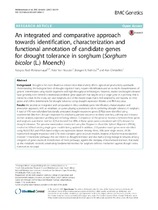An integrated and comparative approach towards identification, characterization and functional annotation of candidate genes for drought tolerance in sorghum (Sorghum bicolor (L.) Moench)
Date
2017Author
Woldesemayat, Adugna Abdi
Van Heusden, Peter
Ndimba, Bongani K.
Christoffels, Alan
Metadata
Show full item recordAbstract
BACKGROUND: Drought is the most disastrous abiotic stress that severely affects agricultural productivity worldwide.
Understanding the biological basis of drought-regulated traits, requires identification and an in-depth characterization of
genetic determinants using model organisms and high-throughput technologies. However, studies on drought tolerance
have generally been limited to traditional candidate gene approach that targets only a single gene in a pathway that is
related to a trait. In this study, we used sorghum, one of the model crops that is well adapted to arid regions, to mine
genes and define determinants for drought tolerance using drought expression libraries and RNA-seq data.
RESULTS: We provide an integrated and comparative in silico candidate gene identification, characterization and
annotation approach, with an emphasis on genes playing a prominent role in conferring drought tolerance in sorghum.
A total of 470 non-redundant functionally annotated drought responsive genes (DRGs) were identified using
experimental data from drought responses by employing pairwise sequence similarity searches, pathway and interprodomain
analysis, expression profiling and orthology relation. Comparison of the genomic locations between these genes
and sorghum quantitative trait loci (QTLs) showed that 40% of these genes were co-localized with QTLs known for
drought tolerance. The genome reannotation conducted using the Program to Assemble Spliced Alignment (PASA),
resulted in 9.6% of existing single gene models being updated. In addition, 210 putative novel genes were identified
using AUGUSTUS and PASA based analysis on expression dataset. Among these, 50% were single exonic, 69.5%
represented drought responsive and 5.7% were complete gene structure models. Analysis of biochemical metabolism
revealed 14 metabolic pathways that are related to drought tolerance and also had a strong biological network, among
categories of genes involved. Identification of these pathways, signifies the interplay of biochemical reactions that make
up the metabolic network, constituting fundamental interface for sorghum defence mechanism against drought stress. CONCLUSIONS: This study suggests untapped natural variability in sorghum that could be used for developing drought
tolerance. The data presented here, may be regarded as an initial reference point in functional and comparative
genomics in the Gramineae family.

